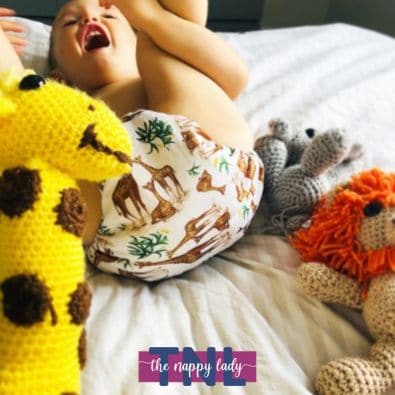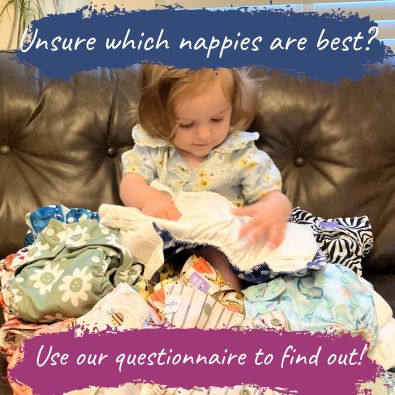Changing Wriggly Children

No, this section doesn't tell you how to swap them for less troublesome offspring, but offers tips on how to minimise the hassle at nappy change time and how to change a nappy when baby rolls!
Firstly, you are not alone! At some point or other most parents experience a wriggly child. For some it’s a short phase, but for others it can last much longer. Like everything in parenting there is no magic answer and the same solution will not work for every parent or every child, so it can be trial and error to see what works for your family. Below we have some handy tips that can help you through this stage.
There is no perfect nappy for changing a wriggly child. Both reusable and single use have advantages and disadvantages, which we will discuss later.
Why do children wriggle?
There are many reasons a child would rather wriggle away than have their nappy changed. Understanding why your child wriggles can help to find the best solution for you.
Reasons include (but are definitely not limited to):
-
Feeling cold
-
Dislike being undressed
-
Don’t want to lie down
-
Would rather play (this is a very common one)
-
They can see something that they want to reach
-
You’ve stopped them doing something else they were enjoying
Wriggling (and then escaping) is something that develops gradually, so you may find that some of these techniques work best early on, while others are for when you have a child to chase round the room.
What I can do to stop baby rolling during nappy change?
Don’t Change on the Floor
Anecdotal evidence suggests that wriggling is less likely to develop into full scale escapology if there is nowhere for your baby to go except down! The more limited the surface they are used to, the sooner they tend to outgrow this phase. Change tables are great, but any small household space will do just as well. Generally this method is better for a younger child, and for safety reasons you may need to use the floor with an older child to eliminate the risk of falling.
I should of course point out that you should never leave your child unattended on a raised surface, even briefly. It is incredibly easy for a baby or child to fall off a surface when only left for a second, as Mr Nappy Lady found out.
Distraction Techniques
This is the most common method that parents use. When a child is attempting to wriggle away, simply finding something else to catch their attention is often the most successful way of completing a nappy change.
Try bringing out the following at nappy change time:
-
TV
-
A toy
-
Cot mobile
-
Musical toy
-
Heavier toy (not too heavy but not light either)
-
A spare nappy
-
A wipe
-
Lid from a tub/container
-
Baby mirror
-
Anything shiny
-
Something they aren’t usually allowed
-
Singing to them
Even nurseries are known to have a special set of toys that can only be played with during nappy change time.
You may find that whatever you use to distract the child quickly loses its appeal (it’s not new and fun when they played with it at the last nappy change) so you may need a selection of items that you frequently rotate.
TNL Tip – Do not give them the distraction item early, doing so frequently results in the item losing its appeal just at the time you need it to be effective. Try to give it at the last possible minute.
Physical Limitation
We know this sounds scary and for many parents this is understandably a last but necessary resort. The trouble with this method is that you suddenly need to become an octopus to have enough arms and legs to hold them down. It also means that when someone else comes to change your child later they are likely to struggle. Another disadvantage of this method is that it tends to encourage the escape mentality and children can often then think it’s a game to escape and run off.
When there are two of you to hand, one can employ a mixture of limitation and distraction techniques while the other sees to the business end of things. Although this is not practical for everyday use (unless you always travel in pairs), it can be quite useful where you have a partner who changes nappies as well, but not frequently enough to have mastered the art of holding their offspring down at the same time, particularly when a poopy nappy is involved. I lost count of how many times my husband and I have asked each other to hold the baby’s hands as they had done a poo and there just aren’t enough hands to do it alone!
Forbid It
Being firm at nappy change time from the beginning, before wriggling has a chance to develop, may save you a lot of wasted time later on. You would need to be consistent, if this is your route. I have never managed it for my children, because it is just not my style, but it might be yours.
Work Round It
Traditionally, you change a nappy by having your baby lie on their back, and put the nappy on around them. However, there is no rule that says this has to be the way. Once your baby gets to the wriggling stage, they are usually fully capable of sitting or standing, which you can use to your advantage if they’re happier to stand for a change than lie down. Changing on your lap can be an option too, though higher risk if you’re not confident that another wee isn’t on its way!
My first child hated laying down for nappy changes and just wanted to be stood up. I used Bamboozles with an Airflow wrap so I would quickly do the nappy while distracting him then let him get up. He would happily cruise around the furniture while I chased him putting the Airflow on while he stood/cruised the furniture.
Be Philosophical
If it helps, you can bear in mind that there will come a point at which your child will actually help at nappy change time, by lying down on the mat themselves, or even helping to wipe (which can be a mixed blessing, especially if poo is involved!). Like everything else, escapology at nappy change time is simply a phase.
Does the nappy I use make a difference?
Single use nappies
While a single use nappy can be considered easier as the fit can be more forgiving, it’s worth bearing in mind that should you need to undo the fastening a few times it can quickly lose its stick and you may have to get a whole new nappy.
Reusable nappies
There are so many styles of reusable nappy that you’re sure to find one that works for your wriggly child. Here are some positives and negatives of different types and different things to consider:
Nappies that don’t need tucking into the knicker line
A nappy that doesn’t need to be tucked into the knicker line is often quicker to fit especially on a wriggly baby. Some examples would include Mother-ease Wizard Duo, Mother-ease Wizard Uno, Little Lovebum Popper & Pocket, Little Lovebum all-in-ones.
No rolled elastic
Choosing a nappy without rolled elastic removes the final step of running fingers around the legs and makes changing quicker.
Type of nappy
There are many opinions on this. Lots find a pocket or all in one nappy easiest for a wriggly child as it’s only one layer to put on and can be fitted faster than a two parter. Although if you need reliability the two parter can be a better option as the wrap can still contain anything missed by a less than optimally fitted nappy!
Velcro or snaps?
Velcro is quick and easy to fasten and you can undo and adjust it easily. Wriggling children often have wandering hands so can undo Velcro. This can especially be a pain if you do one side up and they undo it before you fasten the other. While it’s very common to find a baby that likes to undo their Velcro, you still might find yourself with one of those particularly talented babies who have worked out poppers too!
Snaps can appear more difficult at first as they are slower to fasten, however once you know which popper you use, you can do one up then distract the child before doing the other. The side that is fastened often holds more securely. Nappies without a stability popper are faster as there is one less to do up, but it can also be an advantage as it can help give a better fit and again you can just fasten that one popper then pause before doing the others. Vertical poppers tend to be easier to line up and know where the next popper is fastening.
Stretchy tabs
These have a much more forgiving fit and are often quicker to fasten than nappies without.
Pull-up nappies
With the Mother-ease Sandy’s nappy and Airflow wrap you can do up three of the four poppers, put them on like pull on pants and then do up the final popper. You could also do up the fourth popper, but then you would be stretching the elastication every time, which might weaken it. Leaving one popper open avoids this risk.
If you use two part nappies, a pull up wrap can save valuable seconds. You still have to fasten the nappy, but a pull up wrap goes on much quicker.
Practice Makes Perfect
You’ll often find that the more nappy changes you do, the more both you and your child get used to it. With a wriggly child, speed can be of the essence so choosing a nappy that you’re familiar with and can put on quickly is often far easier than something new that needs more attention.
Changing Mats
Read our changing mat article for more information about changing mats and the essentials you need.
Changing Frequency
For more information on nappy change frequency read our article on how often to change cloth nappies.
